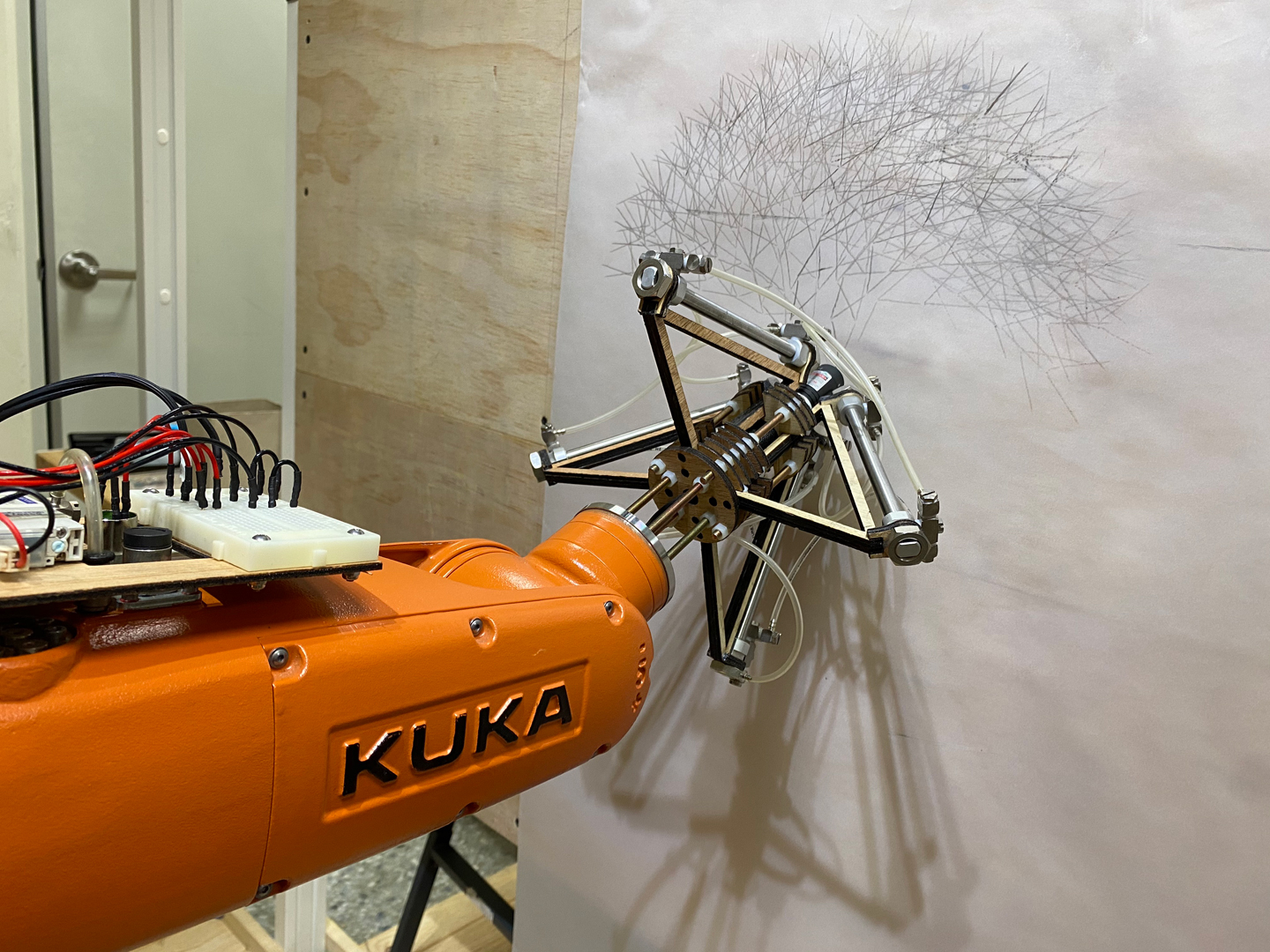Scottie Chih-Chieh Huang, Chi-Li Cheng: Dreaming With Dandelion
Artist(s):
Title:
- Dreaming With Dandelion
Exhibition:
Category:
Artist Statement:
Summary
In this robotic art project, we are developing a series of autonomous behavior as fictional design to mimic that robot has its own conscious. We make robot holding a pencil for drawing line-based illustration, metaphor robot is dreaming.
Abstract
In this robotic art project, we are developing a series of autonomous behavior as fictional design to mimic that robot has its own conscious. We make robot holding a pencil for drawing line-based illustration, metaphor robot is dreaming, according to in ”Do Androids Dream of Electric Sheep?”, whether you can dream is used as a romantic question to test between life and artificial life. In the system, the industrial robot independently explores the Environmental Information through the depth sensor and AI system in exhibition space. And then the detected data will used to input into Dandelion-like Generative System(DGS), which made by algorithmic data structures from fractal tree and L-system for mimic nature phototropism mechanism and growing processes. Finally, we used grasshopper develop a mechanism to convert the line- base dandelion diagram into robotic painting by manipulation paths and gripper’s act, to make robot physically holding the pencil to draw it out on a paper. This installation will painting an unique dandelion illustration per day, it can also see as specific data visualization by its dynamical physical environment. This stroking processes and its painted outcome can see as a hybrid creation combining computational aesthetics and Robotic Stroking.
Technical Information:
1. Environmental Information: The virtual dandelion mechanism that we build is so sensitive to environmental information; we attempt to make good use of this characteristic to visualize the abstract and complex environmental information. In this project, the growth process is influenced by environmental information. The system keeps observing the environment and processes the information with an autoencoder-based algorithm. The form is the representation of the accumulation of environmental information over time. These simplified data performance as digital wind to wave and influence the growth of the virtual dandelion. Nowadays, various kinds of sensors help people to observe the environment with various formats of data trying to aggressively explain what they have senses ; however, they just bring about complexity and noises, disturbing our life. On the other hand, recently, the computer seems to be able to think deeply and help us to face the situation. For instance, extremely complex data can be organized by the autoencoder algorithm; these simplified and crucial information emerge through the network. We value phenomenon so much because it can truthfully tell us what is really important when we are overwhelmed by the complexity of digital information data. The overall emergence process of the dandelion result in serenity and simplicity helping people to comprehend the digital data from a new perspective. In summary, the system process the environmental information, generating the drawing based on the information. the process can be view as an artificial dream system; to some degree, we explore the possibility that the machine could be slightly creative since the machine is able to organize information and represent the thought by drawing. Furthermore, a result of a graph that robot draws is correspond to the each kind of environmental information so that human could understand after comparing the graph and the corresponding environmental information; we anticipate that graph will be the media between human and the machine. In this way(with graph) to comprehend the thought of a machine might be more and more common in the future than reading the code recently because comprehending the graph is instinctive for human; it could render people empathy toward the machine and streamline the communication with the machine.
2. Dandelion-like Generative System (DGS): Inspired by nature’s process of morphogenesis, through the growth and reproduction mechanism of cell division, for producing multiple and complex appearances. The dandelion-like generative system is made by using generative rules for developing nature mechanism from symmetry, reproduction and adaptation for create dandelion-like illustration. We developing a mechanism made by algorithmic data structures from fractal tree and L-system for applied real time environmental information of light and pedestrian, acting virtual dandelion growth following the physical information, acting like hybrid phototropism did.
3. Robotic Stroking: We choose using robots to stroke the dandelion on a paper in the order of growth process as a means to present our work. Consequently, the emergence of the dandelion is similar to humans’ work that these abstract ideas from humans’ brain to hands then the idea becomes reality in the physical world. In our view, the motion of drawing is also crucial for humans to accept the dandelion because humans are familiar with the process that abstract ideas are converted to strokes in order by hand; the process also reveals the logic of the work, fascinating people, making people empathize with the work’s creator. Therefore, in this project, the dandelions are stroked by the robot with quite plain technique like humans do; he needs to grab and sharp the pencils; moreover, he also attempts to adjust the pencils in order to stroke any part of the dandelion evenly and properly, avoiding destroying the paper and mechanism, making the strokes not too dark or light.





